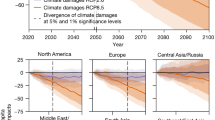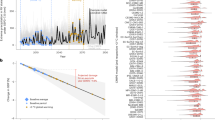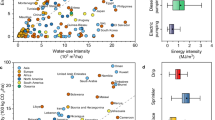Abstract
Power plants that require cooling currently (2015) provide 85% of electricity generation in the United States1,2. These facilities need large volumes of water and sufficiently cool temperatures for optimal operations, and projected climate conditions may lower their potential power output and affect reliability3,4,5,6,7,8,9,10,11. We evaluate the performance of 1,080 thermoelectric plants across the contiguous US under future climates (2035–2064) and their collective performance at 19 North American Electric Reliability Corporation (NERC) sub-regions12. Joint consideration of engineering interactions with climate, hydrology and environmental regulations reveals the region-specific performance of energy systems and the need for regional energy security and climate–water adaptation strategies. Despite climate–water constraints on individual plants, the current power supply infrastructure shows potential for adaptation to future climates by capitalizing on the size of regional power systems, grid configuration and improvements in thermal efficiencies. Without placing climate–water impacts on individual plants in a broader power systems context, vulnerability assessments that aim to support adaptation and resilience strategies misgauge the extent to which regional energy systems are vulnerable. Climate–water impacts can lower thermoelectric reserve margins, a measure of systems-level reliability, highlighting the need to integrate climate–water constraints on thermoelectric power supply into energy planning, risk assessments, and system reliability management.
This is a preview of subscription content, access via your institution
Access options
Access Nature and 54 other Nature Portfolio journals
Get Nature+, our best-value online-access subscription
$29.99 / 30 days
cancel any time
Subscribe to this journal
Receive 12 print issues and online access
$209.00 per year
only $17.42 per issue
Buy this article
- Purchase on Springer Link
- Instant access to full article PDF
Prices may be subject to local taxes which are calculated during checkout




Similar content being viewed by others
References
Ventyx Power Plant Database (National Renewable Energy Laboratory, 2016).
Energy Information Administration Electricity Generation Dataset Form EIA-923 (accessed 2016).
Macknick, J., Newmark, R., Heath, G. & Hallett, K. C. Operational water consumption and withdrawal factors for electricity generating technologies: a review of existing literature. Environ. Res. Lett. 7, 045802 (2012).
Feeley, T. J. et al. Water: a critical resource in the thermoelectric power industry. Energy 33, 1–11 (2008).
Carter, N. T. Energy’s Water Demand: Trends, Vulnerabilities, and Management (Congressional Research Service, 2010).
Averyt, K. et al. Freshwater Use by US Power Plants: Electricity’s Thirst for a Precious Mresource, A Report of the Energy and Water in a Warming, World Initiative (Union of Concerned Scientists, 2011).
The Water-Energy Nexus: Challenges and Opportunities (US Department of Energy, 2014).
van Vliet, M. T. H., Wiberg, D., Leduc, S. & Riahi, K. Power-generation system vulnerability and adaptation to changes in climate and water resources. Nat. Clim. Change 6, 375–380 (2016).
Bartos, M. D. & Chester, M. V. Impacts of climate change on electric power supply in the Western United States. Nat. Clim. Change 5, 748–752 (2015).
Forster, H. & Lillenstam, J. Modeling thermoelectric power generation in view of climate change. Reg. Environ. Change 10, 327–338 (2010).
Miara, A., Vörösmarty, C. J., Stewart, R., Wollheim, W. & Rosenzweig, B. Riverine ecosystem services and the thermoelectric sector: strategic issues facing the northeastern United States. Environ. Res. Lett. 8, 025017 (2013).
Summer Reliability Assessment (North American Electric Reliability Corporation, 2015).
Fay, J. A. & Golomb, D. S. Energy and the Environment: Scientific and Technological Principles 2nd edn (Oxford Univ. Press, 2012).
Micheletti, W. C. & Burns, J. M. Emerging Issues and Needs in Power Plant Cooling Systems (accessed 2012).
McCall, J., Macknick, J. & Hillman, D. Water-Related Power Plant Curtailments: An Overview of Incidents and Contributing Factors NREL Technical Report NREL/TP-6A20-67084 (National Renewable Energy Laboratory (NREL), 2016).
Scanlon, B. R., Duncan, I. & Reedy, R. C. Drought and the water-energy nexus in Texas. Environ. Res. Lett. 8, 045033 (2013).
Melillo, J. M., Richmond, T. (T. C.) & Yohe, G. W. (eds) Climate Change Impacts in the United States: The Third National Climate Assessment 841 (US Global Change Research Program, 2014); http://dx.doi.org/10.7930/J0Z31WJ2
Temperature, Water Quality Standards Criteria Summaries: Compilation of State/Federal Criteria (United States Environmental Protection Agency (EPA), 1998).
Leeper, S. A. Wet Cooling Towers: Rule of Thumb (US Department of Energy, Idaho National Engineering Laboratory, 1981).
Roy, S. B. et al. Projecting water withdrawal and supply for future decades in the US under climate change scenarios. Environ. Sci. Technol. 46, 2545–2556 (2012).
van Vliet, M. T. H. et al. Vulnerability of US and European electricity supply to climate change. Nat. Clim. Change 2, 676–681 (2012).
Schaeffe, R. et al. Energy sector vulnerability to climate change: a review. Energy 38, 1–12 (2012).
Quadrennial Technology Review, An Assessment of Energy Technologies and Research Opportunities (US Department of Energy, 2015).
Stewart, R. J. et al. Horizontal cooling towers: riverine ecosystem services and the fate of thermoelectric heat in the contemporary northeast US. Environ. Res. Lett. 8, 025010 (2013).
Miara, A. & Vörösmarty, C. J. A dynamic model to assess tradeoffs in power production and riverine ecosystem protection. Environ. Sci. Process. Impacts 15, 1113e26 (2013).
Hempel, S., Frieler, K., Warszawski, L., Schewe, J. & Piontek, F. A trend-preserving bias correction—the ISI-MIP approach. Earth Syst. Dynam. 4, 219–236 (2013).
Air Markets Program Data (Environmental Protection Agency, accessed 2016).
Natural Gas Infrastructure Implications of Increased Demands from the Electric Power Sector (US Department of Energy, 2015).
Cohen, S. M., Macknick, J., Averyt, K. & Meldrum, J. Modeling Climate-Water Impacts on Electricity Sector Capacity Expansion (National Renewable Energy Laboratory, 2014).
Macknick, J. et al. Water and Climate Impacts on Power System Operations: The Importance of Cooling Systems and Demand Response Measures NREL Technical Report (National Renewable Energy Laboratory (NREL), 2016).
USGS Water Data for the Nation (US Geological Survey, accessed 2016); https://waterdata.usgs.gov/nwis
National Pollutant Discharge Elimination System—Final Regulations To Establish Requirements for Cooling Water Intake Structures at Existing Facilities and Amend Requirements at Phase I Facilities; Final Rule (United States Environmental Protection Agency (EPA), 2014).
Acknowledgements
This work was carried out under the National Science Foundation’s Water Sustainability and Climate grant #1360445. We thank A. Agrawal, F. Corsi, N. Devineni and B. Roberts for their contributions.
Author information
Authors and Affiliations
Contributions
All authors contributed to discussions, and the first five to the writing, of the paper. A.M., J.E.M., C.J.V., B.F. contributed to conceiving and designing the experiments. A.M. performed the experiments and data analysis.
Corresponding author
Ethics declarations
Competing interests
The authors declare no competing financial interests.
Supplementary information
Supplementary Information
Supplementary Information (PDF 2443 kb)
Rights and permissions
About this article
Cite this article
Miara, A., Macknick, J., Vörösmarty, C. et al. Climate and water resource change impacts and adaptation potential for US power supply. Nature Clim Change 7, 793–798 (2017). https://doi.org/10.1038/nclimate3417
Received:
Accepted:
Published:
Issue Date:
DOI: https://doi.org/10.1038/nclimate3417
This article is cited by
-
Complex interplay of water quality and water use affects water scarcity under droughts and heatwaves
Nature Water (2023)
-
Mitigation policies evaluation in the electric power sector for carbon neutrality, water conservation, and economic growth in the Beijing–Tianjin–Hebei region: a simulation with multi-regional dynamic CGE model
Environment, Development and Sustainability (2023)
-
How climate change affects electricity consumption in Chinese cities—a differential perspective based on municipal monthly panel data
Environmental Science and Pollution Research (2023)
-
Integrated hydrological, power system and economic modelling of climate impacts on electricity demand and cost
Nature Energy (2022)
-
Numerical simulation of the thermal pollution zones formation from the power plant for different weather conditions
International Journal of Environmental Science and Technology (2022)



